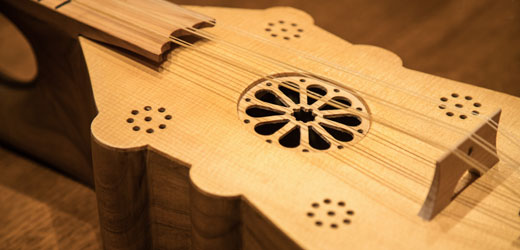PLUCKED STRINGS (PLECTRUM) | Level 2 – Intermediate
Citole/Gittern/Psaltery II: Secular and Religious Songs and Dances
6 sessions - Self-paced
Online
Course Description
Plucked string instruments such as the citole, the gittern, and the psaltery, were used during the middle ages to accompany vocal compositions, to play instrumental versions of vocal music, and to perform instrumental pieces. They were employed both by jongleurs and clerics as solo instruments or within instrumental ensembles. The players utilized different techniques for the performance of single lines and to accompanying melodies (stationary and movable droning, parallel melodic movement, and intervallic change). The use of plectrum(s) produced a brighter and louder sound, with more attack, and the possibility of performing tremolos and faster notes.
In this course students will:
Develop plectrum techniques
Perform pieces of the instrumental repertoire
Learn how to accompany the voice or another musical instrument
Learn to arrange vocal compositions for instrumental performance
Explore a wide variety of medieval monophonic repertoires (religious and secular)
Study rhythmic interpretation, phrasing, accompaniment and the creation of preludes, interludes and postludes
 Instructor:
Instructor:
Martí Beltrán
COURSE INFO
DATES & DURATION
February 19 to June 10, 2024
6 sessions – Self-paced
Location
Online
Price
1 credit ECTS: 360€
Languages
English - Spanish
Level
Level 2 / Intermediate
Prerequisites
Musicians with intermediate or advanced technique on the selected instrument (or has taken beginner course) and basic knowledge of Medieval music notation.
Access to a medieval instrument or related plucked string instrument is necessary. Please check with us.
Syllabus
Teaching Methodology
This course will be comprised of:
-
- 6 virtual one-on-one lessons (1 hour each)
- Recorded introductory lecture or one group live Q&A session (30 min)
- 6 tutorial videos (10-15 minutes each)
- Downloadable materials and links to additional resources
Schedules and assignments:
-
- The class dates and times will be scheduled with the instructor.
- There will be some suggested deadlines to submit assignments.
- The student workload to take the lessons, review the materials and practice is approximately 4.25 hours per session.
- Students taking the course for credit must complete all assignments and class requirements.
Technical Requirements
-
- Broadband Internet connection / WIFI
- External or internal webcam
- External or internal microphone
- Speakers or headphones
- Possibility of printing downloaded materials
- Possibility of scanning your assignments
- Possibility of auto-recording (audio and video)
Enroll Now
Places are limited for each section, so sign up early.





